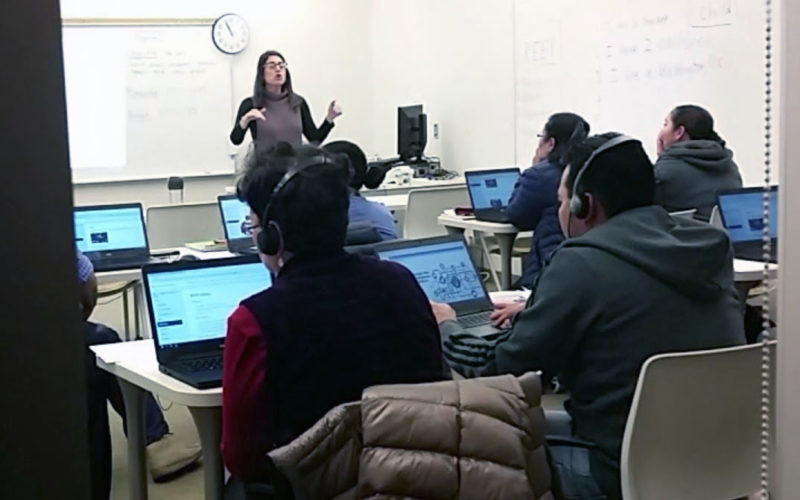Tips for Building a Successful Adult Education Class

by Freida Idsi-Cole
Adult learning classrooms, virtual or otherwise, are a melting pot of individuals with a broad range of reasons: to find employment, to learn English, to learn to read and write, to try again at finishing high school, or to learn a skill they have always wanted to attain.
Whatever the reasons, each class has a diverse cohort which comes with a very wide range of capabilities. And therein lies one of the biggest challenges for teachers—identifying the starting point that doesn’t overwhelm some whilst remaining challenging enough for others. For this we can turn to differentiation, ensuring that each of our activities and assignments has extension exercises to stretch those that have grasped ideas and concepts quicker than others.
But what about specific techniques for adult learners? How can we improve engagement in adult education, particularly now that we are navigating online learning and students have the added pressures and distractions of learning home in the “new normal”?
 Allow students to contribute to the design of their learning.
Allow students to contribute to the design of their learning.
Adult learners are practical in their approach to learning. They are not interested in something that will benefit them ten years down the line. They want to know that time invested now will make an impact on their life straightaway—that they can reap realworld benefits and apply that learning to every day life. I suggest that where possible, students should contribute themselves to the design and development of their lessons, within reason of course. For example, let’s take numeracy. In advance of each module, you could ask your class to choose the subject matter for the assignments and exercises—think of what could be relevant and give a choice—household budgeting, taxes, or calculating deals and discounts in the supermarket. Your group will choose what is of most interest or most useful to them, or which they find the most fun—but overall they will be invested in the module because they have become part of the design process which is key for adult learners. They want to be involved, and they want to know that what they are learning will directly impact their lives, and this addresses both. I appreciate that some subjects and courses will be easier to tie in to real-life scenarios than others, but where it’s not possible, think about topics that would interest the group, and again, let them make the final decision on the assignment topics and subject matter so that they are contributing to the design of their learning.
 Adapt new concepts to everyday subjects.
Adapt new concepts to everyday subjects.
Abdul Malik Muftau (2014) from the Teachers College of Columbia University highlights that “kids learn faster than adults because the prefrontal cortex of the brain, where working memory is stored, is more developed in adults than children” (unpaged). This development means that “adults experience functional fixedness and that makes adults see everything as it is” (unpaged). Kids’ minds are flexible, therefore making it easier for them to pick up new concepts. With this in mind, adapting new concepts to subjects that adult students can use and visualize from their everyday lives will help them to learn while enabling them to recognize the subject matter and the concept they are learning.
 Design for quick wins.
Design for quick wins.
Another important consideration with adult learning relates to student confidence, or lack thereof, in learning. Returning to education is daunting, particularly if it did not go well the first time or if it has been some time since they have studied. Building motivation, self-esteem, and confidence in their own abilities is an important hook to keep adult learners engaged. When designing your course content and modules, it is worth starting with an assignment, area, or concept that will allow you and your students to see “quick wins”. Start with the easier concepts, even if it is not always the natural order to do things, and this will help remove any anxiety they have about not being capable. It will give them a natural stepping-stone of confidence and ability for the more detailed or complex areas. For example, when teaching definite and indefinite articles in literacy or English as a second language, couple this grammar topic with simple vocabulary such as fruit and vegetables, which people already have a familiarity with from supermarkets, restaurants, and menus. That way they are accomplishing two new skills, but at least one of them they can pick up easily, leading to a feeling of success and a desire to keep learning and achieving.
Lastly, keep it interactive, keep it fun, and don’t be afraid to go off topic. Adult learners have a wealth of knowledge and experience and are used to discussing views, giving opinions, and sharing knowledge. Giving the odd five minutes here and there can help build bonds and an inclusive community, and that too helps with student engagement and retention.
Reference
Muftau, A. M. (2014, May 4). Do kids learn faster than adults? Gottesman Libraries, Teachers College, Columbia University. https://blog. library.tc.columbia.edu/b/10822-Do-KidsLearn-Faster-than-Adults#:~:text=Kids%20 learn%20faster%20than%20adults%20 because%20the%20prefrontal%20cortex%20 of,everything%20exactly%20as%20it%20is
 Freida Idisi-Cole serves as Program Manager for the Franklin City Public Schools Adult & Continuing Education program. Freida manages the adult basic education and English literacy program within the division which includes planning, organizing, developing, implementing, and evaluating adult education services. She collaborates with agencies and organizations within the community to build relationships with vulnerable populations to offer them the education, training, and job placement support they need the most. She is an advocate for life-long learning and progress.
Freida Idisi-Cole serves as Program Manager for the Franklin City Public Schools Adult & Continuing Education program. Freida manages the adult basic education and English literacy program within the division which includes planning, organizing, developing, implementing, and evaluating adult education services. She collaborates with agencies and organizations within the community to build relationships with vulnerable populations to offer them the education, training, and job placement support they need the most. She is an advocate for life-long learning and progress.